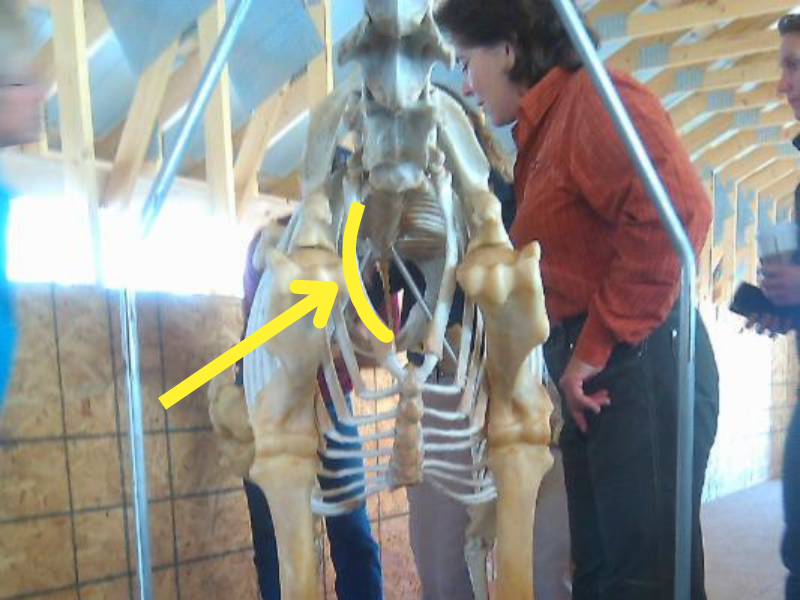
The Importance of the First Rib in Horses
Join us in this episode of Holistic Horseworks Talks with April Love as we explore the often-overlooked significance of the first mobility rib in equine anatomy. She sheds light on how misalignments of the first rib can lead to various issues with people such as thoracic outlet syndrome, frozen shoulder, tendonitis, bursitis, and carpel tunnel syndrome. So think about all the things it could be impeding your horse’s freedom of movement in the front end. This is what starts the high-low hoof syndrome, horse not picking up right or left lead, mysterious lameness, kissing spine, behavioral issues, and even roaring in horses requiring expensive tie-back surgery.
Episode Transcription
Expand to read more...
Welcome to Holistic Horseworks talks. Join us with founder April love as we talk about equine care. Learn what you can do to keep your horse happy, healthy, rideable and sound through their 30s. Have a question you’d like to submit to the podcast? Just email april@holistichorseworks.com for a chance to get it featured on the next episode.
April Love: 0:26
So, I actually work on people as well, too. So, you know, on a people skeleton, because I don’t have a horse So that’s the same thing on horses. So where’s the first skeleton. Here’s our first rib and a lot of the chiropractors serve on the horses? Jean, my UK instructor found me in 2010 and came to the States because she was doing cranial sacral. And everything kept pointing back to the thoracic outlet impingement and the first rib but no one else was talking about it. So and we can post a picture like this, you know, online, but here is a horse skeleton. Okay, you know, and you can see where the first rib is all the way up deep under the point of the shoulder. So all it does, is it tweaks a little bit sideways and how does and body workers are missing getting this adjusted. And when it get tweaked? So horse running through a pasture in winter mud bog, gopher holes, pulling a front shoe with a hind some horses that continually have both first ribs misaligned are leaning over a solid fence to graze on the other side. A horse trailer straight load, two horse straight loads stopping hard and the shoulders get pushed. Okay, all of those things, especially in foals, you’ll see a foals running and take like a whole tough tumble somersault and like we need to go work on that foal. we take a fall, neck muscles up here, when your neck kind of So on this picture, which is hard to see, but I have it on YouTube and I have it in my classes and stuff. The right goes this way, and your shoulder kind of goes the other way. Just shoulder has no gap. I don’t know if you can see this with the glare and the left shoulder has a gap here. So all it is is kind of tips that rib up. It’s not like ribs come out. They’re that the shoulder can’t come through freely. Not that it’s So the foals it starting as early as you know, a couple of days old couple of weeks old it’s starting the starting the high low hoof syndrome. It’s creating tendon and suspensory strain and tear. When we think it’s a weakness, we think, oh, this horse just doesn’t have the muscling to go to the right. So causing a lot of pain but the right shoulder can’t move we need to work him or if the right shoulder can’t work correctly. The left one has to work twice as hard but a horse works the diagonal right? So if it can’t move this shoulder, not poking. So people say oh, it’s first ribs out, and I try it’s going to kind of lift its body and tweak it and it’s going to go back to the left hind leg. So if first rib is out on the freely. So on this horse, okay, he wouldn’t have wanted to take right side, the right stifle is going to have issues this hip is going to be back on the horse and this inside hock on the left hind is going to be tighter and that foot turning in, trying to pick up to give you right lead canter, when really could just fix all that in five minutes. And that’s what my program teaches you. right lead canter. So in how he’s loading the hoof through On horses on the left side, I had a client call me and it and correct the lingo to misaligned so all the ribs creates the horses that roar. And the horses that roar, it’s a flap, um, dealing with recurrent laryngeal nerve, okay. And this is only if it’s on the left side of the horse. So when I worked the lifetime of the horse, the left foot got bigger. That’s on the horse, all the cranial bones were compressed on the left side compressing this end of the nerve and the first rib was out on the left side compressing the other end of the nerve down in a thoracic outlet. And the nerve flap starts to get really lazy. So the horses when they’re worked, will have this should be able to move. Okay, so when I work on people’s issues, your wide hoof your loading hoof. So that would be the 51-52 kind of roaring sound. And the vets will say, Well, you just have to keep riding until it gets worse so we can do the surgery and they call it the tie back surgery. And once you do that three to five thousand dollars and you’re continually tying that flap back, the horse can get dust and food and debris degrees with the low flat heel. This would be your clubby foot straight down in its lungs, it doesn’t have that open closed door. So on that horse, we did the cranial decompression on the left side, fix the first rib issue opened up that home there we did cold laser treatment for nerve tissue breakdown and thoracic outlet, frozen shoulder tendinitis, bursitis, carpal regeneration and fed some herbs to help nerve repair. And he that 54 or 55 degrees can cut this heel down, wouldn’t want to went from a stage four roar, which meant she would lead him next to the golf cart and he couldn’t even trot. Without a rider. He couldn’t get the air to being able to trot freely on a lunge line and be worked again just not be a competition horse. take right lead canter. But on a barrel racing horse, that So it was nice to see that we could you know help repair some of that. So especially if I see performance horses, racetrack horses, hunter jumpers, if they have the cranial bones tunnel syndrome locked up neck, it’s all in the first rib, compressed on the left and the first rib on the left, they’re going to start having those breathing issues. So it’s really important to address all this as a foal. shoulder has kind of already tipped that way so they can do I’m seeing lately with all our hays and grains being so mineral deficient and you know we’ve lost most of our hay fields and what they’re growing they have to put so many chemicals on and Roundup Ready seeds and everything to get better crops. That first rib is being out on 80% of all the horses I work on to good barrels to the right. But they can’t get the shoulder on a regular basis, even my monthly horses, there’s because on us, it locks up the collarbone. So every time you go something in their bodies that it’s not holding that alignment. We have you know, Hawaii here rain mud often you know, so they’re slipping and sliding in it, that kind of stuff. But it used to only be once in a while thing and now it’s all the time. around this rib to take a barrel to the left. So I can walk up to So when I look at horses today, this is 2023, every single horse I see has first rib out on one side, if not both. And the compensation of that actually tips up the he can’t move, you know, this shoulder, this hip is actually coming back a horse and just by the muscling around the shoulder say doesn’t but tipping up. So if it’s out on both sides, the illium to use that shoulder, you’re using these neck muscles to ischium the illium hip right here is actually tipping up on the horse, putting the psoas in spasm and that’s creating the roach back where the horses are up in here just these two bones shifting down your reining horses have that all the time from the sliding stop. So that needs to be addressed like every want to you know do left barrel. So you probably do two rights week when they’re working. Keep the hips in perfect alignment. So my whole program is kind of based on the fact that 99% of the other professional equine body workers out there aren’t bring the shoulder forward and people will get a really short neck. addressing the first rib. Because it’s so deep under the shoulder, they don’t know how to get to it without hurting the and a left or doesn’t want to jump on the right lead because horse, it’s way under the point of the shoulder. And the method that I developed is a two person move where they’re voluntarily doing a movement and then the rib just drops back in. So I teach the gallbladder 20 line checkpoint and how to check if your horses first rib is out of alignment. And if you go out to he can’t get that shoulder up and around. all the horses in your field, you’ll see that they’re all out of alignment and you’ll have tight tendons you’ll have front hooves out of balance and rear hooves out of balance all because of this one little bugger right there. One little bugger that makes lots of big issues. Um, so you told us the importance of it how you know the misalignment can be caused but so now how would we identify and also how often would you say to check for the misalignment? So if people are doing my yoga program once you do this whole body work program, the horse should be able to turn back on the carrot stretch and touch the nose all the way back to the stifle. And if you’re doing that every day because I tell on do that when you’re feeding the horse in the morning. And if they’re touching both stifles you’re usually pretty good. All of a sudden you have a short side, you have something to fix before you tack it up and ride it. So and then that’s one part of the yoga stretch that checks the whole neck and the front end a little bit, but it lets you know what’s going on up there. And if you need something, because, you know, I was training endurance horses, so we turn them out on three acres, they’re flying up and down the hill, you know, so we had to check that every day before you tack it up and ride it because once you tack it up, and ride the horse with the first rib out, you have the whole compensation program again. So I actually have a YouTube video on how to check for first rib misalignment. And if you look at gallbladder 21, it actually says neck to shoulder connection. So we’ll put you know one finger on each side of that point. And I’ll just wiggle with this finger just a little bit, and does the whole chest of the horse shoot over? And then we’ll do this side, we’ll wiggle a little bit. And you’re looking does this you know, shift over? So and we can give you that video link. But it’s not a push, I get people that push so hard. I said yeah, if you push that hard, the horse is gonna move, it’s just finding that gall bladder 21 checkpoint on each side, just the tip of your finger, wiggle, wiggle, does the horse move, wiggle, wiggle and does the horse move? The release that I do is so easy, if you do it correctly, that if the horse doesn’t need it, you’re not gonna hurt them. And if it’s kind of iffy, the first rib could be just a little bit tweaked. So I just tell people do it anyway. And then you’ll notice the second part of my horse yoga is all about, you know, when we do the front leg circles, you know, up and around, it’s freeing all these ribs under the shoulder. So if your horse can’t turn barrels, or is got a heavy choppy trot, you know, going to check the first rib first. But, you know, so ribs come in and tuck into the spine and little synovial joint. So if one’s out, the rest are going to be tweaked by like tight intercostal muscles, you know, when you’ve had like a pinch in your side or a spasm in your side is gonna shorten you that so the whole point of the picking up the front leg and doing the up and around leg circles, is actually to free up all of these ribs. And once these are free, your horse can be light on the front end. And then we’re riding the weakest point. So you know, in my horse yoga and stuff, we always show like lift all the ribs, which kind of frees up the spine. And, you know, because your horse’s spine should be flexible, like a cat, you get some horses that are just trotting with their head up and they’re back hollow and they don’t have any swing and movement. You know, after our program, when the horses come in, they’re walking with their head up and down like this like using the nuchal ligament to try and bring each leg through like this. And when they leave, they look like you know, someone that would be carrying like one of those big, you know, things on their head that heads going this way and the shoulders are going this way, and the whole barrel is swinging to the left and then swinging to the right, and the hips are doing this. And then you know, you have all these different, you know, body parts that can move correctly. They just totally changed when we do this program in one hour, they get four inches longer, two inches taller, and they just seem to expand because if you’ve seen people in pain, you just shut down and you’re like this, you know, you’re not like like in a yoga class where you feel like you really expand and so that’s what I like to give to our people on how to diagnose you know, So my horse I would go out every day. Check first rib and check that withers, mid rib, hips, I would just do a little adjustment, get all those back in alignment, everything thats standing on the four hooves and go back in. It was like 90 seconds. You know, but that’s how we did 2000 miles of endurance with no vet pulls and no lamenesses, keeping his body in alignment every week, not waiting for someone once a month to come and charge me 90 to $120 and mark all these little things on the sheet with big words that I couldn’t understand. And I’s ask ’em, so how did my horse get this way? What do I need to do so it doesn’t come back? And they’re like, I don’t know. See you next month. While you bring it up, do you have any preventative tips to keep that first rib in alignment? It’s happening on all the horses and it’s just the mineral deficiencies and everything so I just tell people to check for it every week and learn how to do the release that’s in my Equine Musculoskeletal Unwinding program, because it’s just a carrot, a friend holding up a leg doing that adjustment, and keeping that horse sound. If you have a horse that goes from an immaculate stall, to an immaculate arena, you’re probably not going to have those issues because he’s not running and playing. He’s not stumbling. He’s not, you know, cantering on right lead and the foot goes down in a mud bog. So it’s when that leg goes down, and the shoulders pulled on that actually tweaks the ribs. So, yes, if you have that perfect environment, but that’s not a horse that’s able to play. So if you’re trying to give your horse that happy out life where they can run and back and jump, again, I have to check it every week. And that’s why I empower, you know, our followers and my students to learn how to do this, and they go help their friends. Oh, yeah, you need to fix your horse. here, let me do that for you. Youu know, so it’s just sharing all the information and empowering others, because it’s a need to fix every week thing. I definitely kind of like what you brought up about how you, there’s nothing you really can do to prevent it. And I know that probably for people, when they start learning about all these things, they’re like, oh, my gosh, this is wrong. This is wrong. I didn’t know I was supposed to be doing with this with my horse, but it’s just, it’s just a matter of the horse’s life. And it just is. Right. So when they were Mustangs and you know, they’d run 5 to 10 miles looking for the minerals and the plants that they eat, they needed in their feed. And, you know, if they pulled a first rib out, they would be the slowest one in the herd. And they’d be the one that was eaten, you know, so but they were, you know, more minerally balanced and their feet were more balanced. When we’re giving our horses this compressed hay and grains and they’re not foraging and moving, and they’re standing and stalls breathing ammonia and slipping in mud, and the smaller an area we keep the horse in the worse the soil gets from the constant hay and urine and pee and stuff. So the condition of the soils change. So I was lucky that my horses had three acres to run on that was hills, because it kept my endurance horses sound and there was three geldings running together so they’re happy and they’re jumping and playing. But yeah, it’s kind of like your dog. Okay, what you do now? All right, let me fix it. But once you learn my program, it’s a 30 second to two minute fix. And you have a happy, healthy, strong horse instead of trying to put them in a bubble wrap and lock this $30,000 horse in a stall and a corral panel, and then all of a sudden, they’re out because they fell asleep next to the corral panel and woke up with their legs in the corral panel. It’s like, yeah, I tried to put my horse in bubble wrap. It just didn’t work.
Lisa: 17:53
They don’t want to be in bubble wrap. They want to have fun. Yeah, well, if you want that balanced mind and body, they need the interaction, they need the head down, they need the grazing, they need the movement, you know, the pasture paradises that a lot of my clients do, where it’s a track, and there’s like hay nets everywhere and different water stations. And when horses would pick on certain horses, they had a one way bar that was suspended that the horse could push through to go to the next stage, but it wouldn’t push this way. So all the ponies that were like getting, you know, picked on by the older horses could go to the next stage, you know, and go to the next stage. So and that was in Indiana, they had such a great place the water’s over there, the hay’s over there, there’s sand over there, there’s gravel over there. So the horses were walking on all these different terrains.
April Love: 18:48
Only all horses can be felt lucky. Yeah, but everyone’s like, well, that horse is kicking my horse. And once you have a kick and a bone, bruise and scar tissue and adhesions, it’s going to permanently change how that horse moves for the rest of their life getting kicked in the shoulder or the sternum. We have so many horses that are girthy and don’t even like when you touch their chest here because their whole sternum has been tweaked. And people say Oh, my horse is always like that. But it doesn’t need to always be like that we can make a change. And my saying is the worst thing you can do is not try. Yeah, absolutely. So I’m hearing from you that you know other than lifestyle hazards and just environmental everyday hazards that the horses encounter that mineral deficiency is a big problem that can lead to you know, the first rib misalignment and probably like a whole bunch of other horse health issues as well. So can, do you have any suggestions on how to overcome mineral deficiencies? So first, you have to learn that a lot of the toxins block the absorption of minerals, so I won’t even get into people’s diet, what they’re feeding if they don’t want to do the detox program on their horse first or themselves because mercury your thymarisol, which is in all your vaccines, blocks the absorption of magnesium, you know on sulfur black selenium. So if you feed a lot of MSM to performance sources, they’re not going to be absorbing selenium. If you don’t have your magnesium, selenium, your heart muscle function, your elasticity and your muscles for your tendons and ligaments and everything. You’re going to have a tight acidic hourse it’s going to have suspensory and tendon tears. So we use the NCD or the ACZ Nana that’s available on Amazon. And it’s just a remover so we do 10 to 15 drops like twice a day for three weeks, especially if you are an overhead chemical fly sprays or have to do all the shots at once you want to when the vet comes, you want to you know do that the week before and during that you’re doing all these chemical stresses. And what taught me this is Tiki my endurance horse, I had already had him on the dynamite supplement for two years. And my naturopath Guru said to put him on the NCD detox. So he did that he’d been on the racetrack, he’d been over vaccinated, overwormed, I did everything holistic at my farm, that just pulling out all the past stuff, you know, so even brood mares, you know, it’s like people the first child, the first foal is going to be the healthiest and the third, fourth and fifth is going to have more health issues and an autoimmune because the liver of the brood mare or the mom couldn’t clean all the toxins of the blood for both. So depending on you know where your foal was born, the first one the fourth or the fifth for how many toxins they have and what they actually came into the world with in their system through the you know, embryonic fluids and stuff. So we do the detox, but on Tiki he was 10 years old already been on the dynamite for two years, just in four to five weeks, my farrier said, so what are you doing his feet are totally different. They’re growing faster, the hoof wall is twice as thick, he doesn’t have the white line anymore, the sole is thicker, I can carve it out concavity when I was competing, we were shoeing every five weeks because you don’t want to change those angles. You don’t want the horse to get really high and then come down really low. When you’re a marathon runner, you want to have those same angles of your running shoe for your tendon suspensories. So that’s what pointed out to me that just the detox was now letting him assimilate all the Dynamite I prefer Dynamite it’s a company in Idaho they won’t sell in vitamins. retail stores they won’t let you know do MLM out of the family . You know, all the products are really good but bioavailable because other products can grind up chalk and say that there’s calcium in it, but it’s not bioavailable calcium to the horse. So if the you know, client owner is willing to do the detox, which is $35 to $80, depending on if they need one or two bottles, they will notice more out of their nutrition program. You shouldn’t have to do a hoof supplement and a coat supplement if the horse is actually getting something good. When I walk up, man, I have a couple of videos on my YouTube channel what I see when I see a horse and we talked about how the skin was but also where this the hair coat looks dull or dead, you know or sunburnt, you know, so if it’s a black horse or a chestnut horse and they’re reddish brown and the hairs are kind of curling up, I know that they’re copper deficient and how do you get bioavailable copper and selenium and magnesium into a horse? We feed the dynamite liquid trace minerals. It’s a colloidal mineral source and the horses can get it from that. You know once they detox and people notice all the muscles go soft the horse is more athletic. After the detox my horse was running at a lower heart rate. So we run with a heart rate on endurance rides and trotting all day in the desert, you know at like 12 miles an hour and my horse should be like, at pulse of 144, well, after the NCD detox clearing out the plaque and everything in the arteries and heart walls and lactic acid and herbicides and pesticides and like chemicals. He was running at 106 to 110. So if you’re going to have a sport or performance horse, you really want to do the passive liver detox so they can assimilate nutrition and pull out the lactic acid and help the liver and kidneys work better. And when your liver and kidneys are clear they can assimilate nutrition. So when I first go up to a horse, and I look in their eye you know, they’re eye will be like really dull like I’m not really home, and after we’ve done the whole product program of the head and the body, the eyes go really dark and clear like you’re looking at a deer’s eye, like oh, look, I can see you in there now. And so the whole change in the horse in just an hour and a half is amazing. But having clients that believe in you for the muscle testing, you know, your horse needs 10 drops twice a day, 21 days. And then see if you’re still magnesium and selenium deficient. Don’t just keep adding more scoops and more scoops because your body’s the horse’s body can’t assimilate it, you’re just pooping it out. Like most people don’t know, you shouldn’t feed all your herbs with all your hardcore minerals. They feed the horse once a day, they want to put 30 different things in one bucket. But if you use a yes/no muscle testing can the horse assimilate it if it’s all together like that. And you get a no, so when I went into menopause, and you’re taking all these different supplements and put them in your smoothie, or just swallow 25 pills in the morning, it wasn’t working. You need to focus on you know, magnesium and selenium and your mineral should like be at night. So a lot of barn situations, you know, can they feed two different feedings with two different things so that your horse can work on assimilating this and assimilating that, not just put it all in one bucket and feed it and hope it works like probiotics should be a liquid. You know, and the powder probiotics aren’t going to work as good. And if you mix that in with apple cider vinegar, and SmartPak and feed two garlic and everything else, and you wonder why nothing’s really working on your horse. So it’s better to split all that out. And there are muscle test points for B and magnesium and that’s in my workbook and you know, selenium and you know what horses that get ulcers, there’s something about that in my horse 102 book as well. So it’s all about remember head teeth, chewing, feet, nutrition, and detox.
Lisa: 27:07
Thank you for tuning in to another episode of Holistic Horseworks talks with April love. Remember to check the show notes for links to all the resources mentioned in this episode. Have a question you’d like to submit to the podcast? Email april@holistichorseworks.com for a chance to get it featured on the next episode. Loved this information? Share it with your horse friends, they’ll find it helpful, too! To learn more, visit holistichorseworks.com. And before you go, make sure you have a copy of our free ebook,
Horse 101: 27:42
Everything You Wish You had Known before You Got Your First Horse, at horseacademy101.com
It’s All Connected
In the world of equine care, ensuring your horse’s well-being goes beyond just basic management. Holistic approaches to horse care have gained traction, highlighting the interconnectedness of various factors that contribute to a horse’s overall health and performance. One crucial element that often goes unnoticed but plays a pivotal role in equine wellness is the first rib. Let’s delve into the significance of the first rib, its alignment, and how it affects a horse’s movement and overall health.
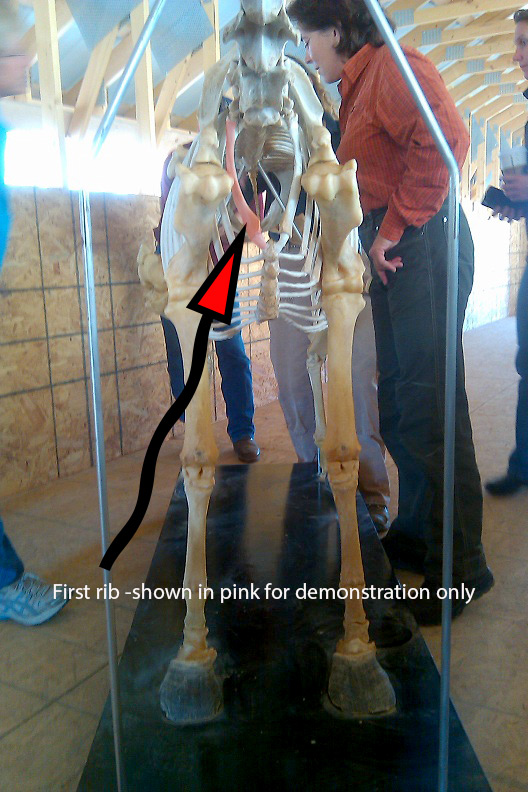
What is the First Rib? What does it do?
To comprehend the importance of the first rib, it’s essential to have a basic understanding of equine anatomy. Similar to human skeletons, horses have a first rib located beneath the point of the shoulder. This rib serves as a critical connection point for various muscles, tendons, and ligaments that support the horse’s body and movement. As such, it plays a key role in the horse’s overall biomechanics, movement, and balance. When misaligned, it can lead to a cascade of issues that impact a horse’s performance, comfort, and well-being.
What Causes First Rib Misalignment in Horses?
Numerous factors can lead to the misalignment of a horse’s first rib. These include activities such as running through uneven terrain, slipping in mud, or experiencing sudden jolts, such as pulling a shoe or stopping abruptly. These actions can cause the first rib to become misaligned, resulting in potential imbalances and compensatory movements. Nutrition also plays a role in maintaining healthy musculoskeletal function, but unfortunately, today most hays and grains that we feed ar horses are mineral deficient which is a result of monocropping, mass production, and chemical additives used for growing.
What are the implications of a first rib misalignment?
Breathing Issues: A misaligned first rib can lead to thoracic outlet impingement, which can affect a horse’s ability to breathe properly. This can result in reduced lung capacity, limited oxygen intake, and overall discomfort for the horse. This can result in issues such as roaring.
Abnormal Gait and Lameness: The misalignment of the first rib can disrupt the horse’s biomechanics, leading to uneven movement patterns and compromised gait. This can impact the horse’s overall performance, making it difficult to perform tasks such as turning, stopping, and transitioning between gaits. Horses with a misaligned first rib may also exhibit gait irregularities, such as choppy or stiff movement. These irregularities can affect their overall performance and potentially lead to lameness.
Muscle Strain and Chronic Pain: A misaligned first rib can cause compensatory movements, leading to strain in muscles, tendons, and ligaments. This strain can result in discomfort, pain, and even injuries over time. If left unaddressed, the misalignment can lead to chronic pain and discomfort for the horse. Chronic pain can affect the horse’s quality of life, behavior, and overall disposition.
Roach Back or Hunter’s Bump: A misaligned first rib can lead to postural changes, including a roached back or other abnormalities in the horse’s spine. This is a result of the horse not being able to move comfortably or freely and overcompensating with other areas of the body, which often cascades to the hind end and a contraction of the psoas muscle.
Poor Performance: A horse with a misaligned first rib may struggle to perform at its full potential due to compromised biomechanics, discomfort, and restricted movement. This can impact various disciplines, from racing and jumping to dressage and trail riding.
How to tell if the first rib is misaligned on your horse
Keep an eye out for gait irregularities, such as choppy or stiff movements, as well as performance limitations that may manifest as difficulty turning, stopping, or transitioning between gaits. Additionally, watch for breathing difficulties, including changes in breathing patterns and potentially, the occurrence of roaring. Look for postural changes, such as a roached back or abnormal spine alignment, and pay attention to signs of discomfort, chronic pain, or tension in the horse’s muscles, tendons, and ligaments. If you notice changes in behavior, reluctance to perform certain movements, especially in the front end, or diminished athletic abilities, these could also be indicators of a misaligned first rib. Regularly assessing these signs and performing evaluations and adjustments can help ensure the horse’s overall health and performance.
How to realign your horse’s first rib
Re-aligning a horse’s first rib is easier than it sounds, and you can do it yourself with the help of a friend! The trick is performing a certain technique that encourages the horse voluntarily performs a specific movement that naturally drops back into alignment without causing discomfort or harm to the horse. In the long term, it’s also important to address potential mineral deficiencies, detoxification, and proper nutrition to support your horse’s overall well-being and assist in maintaining the alignment of the first rib.
Level 1: Equine Musculoskeletal Unwinding Home Study
How to Keep Your Horse Happy, Healthy, and Rideable Thru Their 30’s.
Learn from home with live 1:1 support!
Equine Musculoskeletal Unwinding is all “soft work” but it is very, very effective in correcting gait abnormalities, saddle fitting issues, and mysterious lameness. (What I mean by “soft work” is that you don’t need a lot of strength for these techniques, anyone can do this!) These soft, gentle moves manually release “stuck” areas, including the first rib, to keep the skeleton in proper form and function so that the horse can load the body, joints, and hooves correctly.
Look at your horse from a better perspective, HOLISTICALLY! As well as what you can do to help your horse yourself right in your own barn that will turn them into the willing and agile equine partner of your dreams.

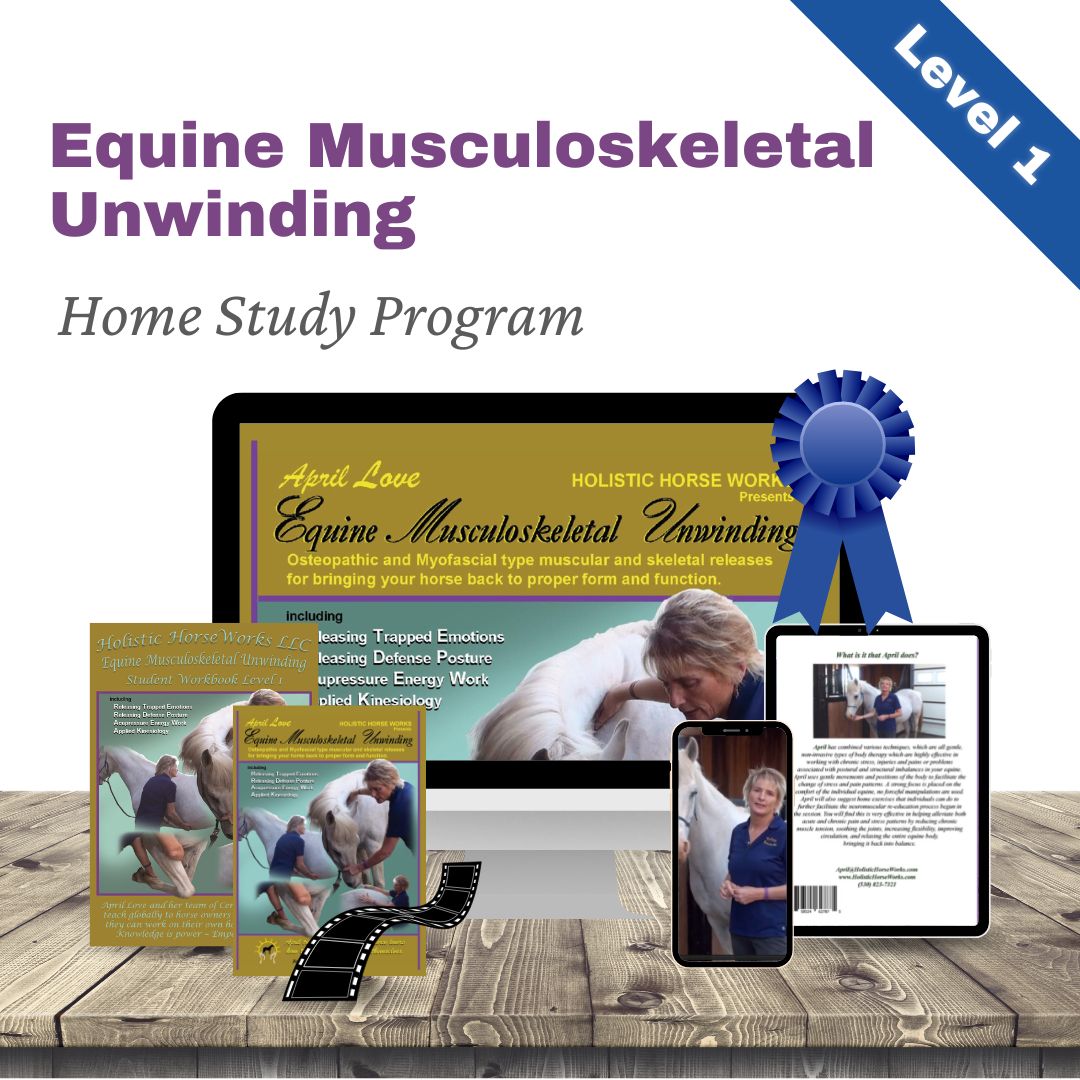
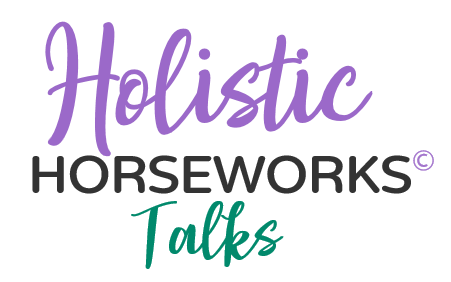
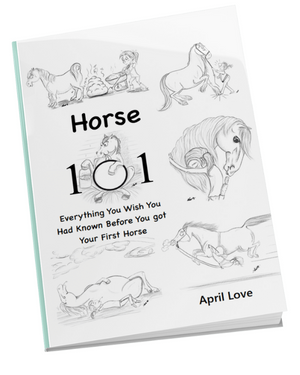
![Complete Level 1 & Level 2 Home Study + Private Training Package [NO DVD]](https://holistichorseworks.com/wp-content/uploads/2022/08/Level-1-and-Level-2-complete-home-study-and-training-package-400x400.jpg)
![Level 1 "Equine Musculoskeletal Unwinding" Home Study -Watch Instantly [NO DVD]](https://holistichorseworks.com/wp-content/uploads/2022/08/Level-1-Home-Study-400x400.jpg)
![Level 2 “CranioSacral Unwinding & Advanced Applied Kinesiology” Home Study - Watch Instantly [NO DVD]](https://holistichorseworks.com/wp-content/uploads/2022/08/Level-2-Home-Study-400x400.jpg)
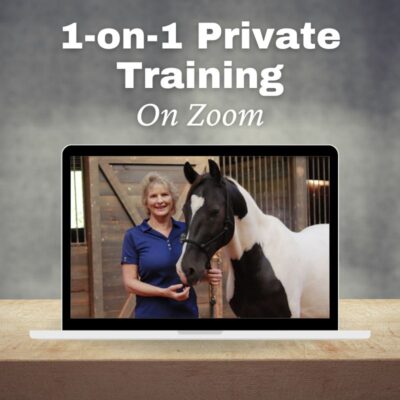
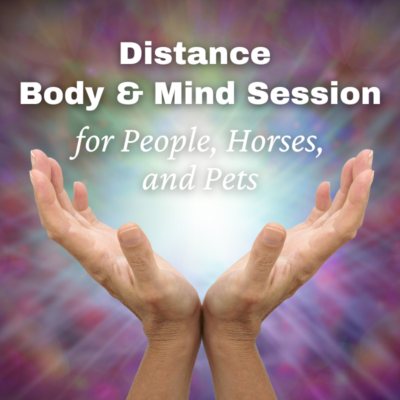
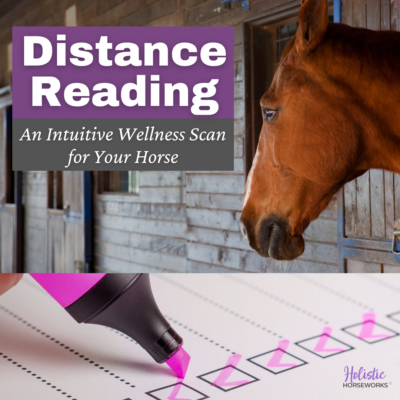
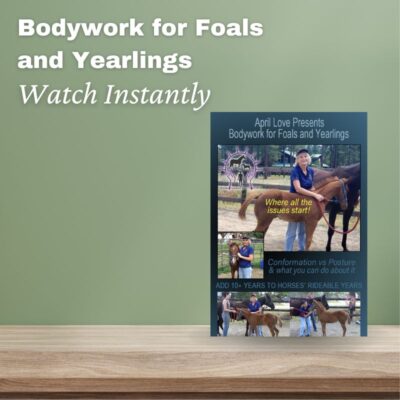
![Equine CranioSacral Energy Work -Watch Instantly [English and French]](https://holistichorseworks.com/wp-content/uploads/2022/09/equine-cranial-sacral-energy-work-watch-instantly-400x400.jpg)